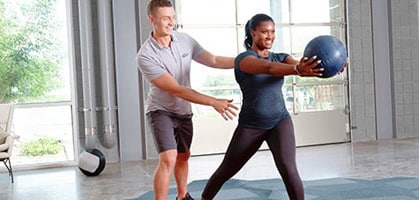If you want to be one of the TOP, most respectable and highly paid personal trainers, it’s simple. Take the first step, get certified as a Certified Personal Trainer (CPT) by NASM (USA).
What You'll Learn
For over 30 years, the National Academy of Sports Medicine has developed the most successful personal trainers in the fitness industry. Our NCCA-accredited personal trainer certification provides you with the most scientifically accurate information, all delivered in our revolutionary digital learning platform.

Our Course Makes Learning Fun & Easy!
This is not your typical 'science' course. Our NCCA-accredited certification utilizes an ‘edutainment’ style of learning - making the course fun, easy and accessible for everyone studying for their personal trainer job! With dozens of Hollywood-style videos and state-of-the-art graphics, even the least-academic person will find themselves truly enjoying the learning process.
Learn the Latest Training Strategies and (Most Importantly!) How to Apply It
Don’t be taught outdated information! Our course is decades ahead of our competitors, and is by far the most comprehensive the industry has ever seen. This course uses the most accurate and up-to-date science, then teaches you how to transform that science into real-world application.
Build a Successful Fitness Career
Learn everything you need to build a successful fitness career working in a gym, or even being your own boss and setting your own hours. The industry’s best personal trainer certification will prepare you for a long and lucrative career working with everyone from weekend warriors to professional athletes.
Train Anyone, Anywhere, Anytime with NASM’s World-Renowned OPT™ Model
The foundation of NASM’s certification is the exclusive Optimum Performance Training® Model. It’s your blueprint for success. The OPT™ Model provides you with a systematic approach to developing personalized and unique training plans that allow you to see predictable outcomes for every client. It’s a flexible and comprehensive system that allows you to create individualized training plans for any client, any time.
Master Accurate, Effective Client Assessments
Assessing, instead of guessing, is critical to successfully training a client. By understanding where the issues in their body are, you can then begin to figure out how to properly address underlying problems that could prevent them from reaching their end fitness goals.
Learn the Art of Behavior Change
Having a plan for your future personal trainer job is great, but knowing how to convince your clients to stick to it is even better. That’s where behavior change comes in. Within our course, you’ll learn the keys to helping people alter behaviors that prevent them from becoming the ultimate version of themselves.

Step1:
Study Your Online Course Material

Step 2:
Pass the Exam

Step 3:
Become an NASM-CPT and start your dream career!
Digital Learning Platform
With the new digital learning platform you will have online all the tools you need to make your study journey easy and enjoyable, anytime and from anywhere.
Take a quick tour to see the training tools and features.

Personal Trainer Certification Curriculum
To be eligible for this personal training course, you must have a high school diploma or GED. Additionally, you need a Cardiopulmonary Resuscitation (CPR) certification and an Automated External Defibrillator (AED) certification. You may enroll in the course before having your CPR and AED certifications; however, you must have them before you take your final exam.
Chapter 1: The Modern State of Health and Fitness
Learn to distinguish your role as a personal trainer, identify common chronic health conditions, differentiate evidence-based practice from fitness fads, and define your scope as a professional.
Chapter 2: The Personal Training Profession
Fitness professionals have the option to work for a variety of employers or to work for themselves. This chapter explores industry growth and the overall career outlook for personal trainers.
- 7 Infographics
- 6 Videos
- 2 Audio Lectures
- 12 Knowledge Checks
Chapter 3: Psychology of Exercise
The role of psychology in fitness and wellness is extremely important. It can deal with several topics, including the way exercise participation affects someone’s mood in both the short and the long term, the effect of weight loss on self-esteem, the motivations to become physically active, and how social influences affect overall exercise behavior.
Chapter 4: Behavioral Coaching
This chapter covers clients’ expectations, assessing behavior change, structuring optimal sessions, communicating effectively, and implementing exercise adherence techniques using behavior change.
8 Infographics
5 Videos
2 Audio Lectures
10 Knowledge Checks
Chapter 5: The Nervous, Skeletal, and Muscular Systems
Because all fitness professionals need an understanding of anatomy and the Human Movement System, this chapter covers the fundamentals of the Nervous, Skeletal, and Muscular Systems.
Chapter 6: The Cardiorespiratory, Endocrine, and Digestive Systems
You will learn how to identify the structure and function of the cardiorespiratory system, how to categorize the function of the endocrine system, as well as the digestive system.
Chapter 7: Human Movement Science
You will gain an understanding of the basics of biomechanics and motor behavior as they relate to working as a personal trainer.
Chapter 8: Exercise Metabolism and Bioenergetics
This section of the course breaks down the various energy systems within the body, providing essential insight into the ways we use food for fuel.
Chapter 9: Nutrition
Improving health and fitness means more than just exercise; it also requires a commitment to improve the way the body is fueled. Although specific diet prescription is outside a trainer's scope of practice, this chapter will provide the basics needed to support nutritional discussions with clients and make recommendations on how to support their goals through a healthy diet.
Chapter 10: Supplementation
It is important that the personal trainer understand what supplements are and how to educate clients on risks associated with various supplements. Within you will learn the necessary information to discuss supplementation with a client while remaining within your scope of practice.
115 Infographics
19 Videos
6 Audio Lectures
30 Knowledge Checks
Chapter 11: Health, Wellness, and Fitness Assessments
After this chapter, you will be able to explain the importance of assessments, collect and summarize subjective client information, identify steps for conducting body composition assessments, and choose the correct cardiorespiratory assessments on an individual basis.
Chapter 12: Posture, Movement, and Performance Assessments
Posture, movement, and performance assessments are an integral part of the intake process for all clients and will assist the fitness professional in developing customized fitness programs to enhance a client’s well-being.
15 Infographics
14 Videos
2 Audio Lectures
10 Knowledge Checks
Chapter 13: Integrated Training and the OPT™ Model
After complete interpretations of assessment results, a comprehensive training program can be developed through application of specific acute variables defined in the NASM OPT™ Model.
Chapter 14: Flexibility Training Concepts
Learn the scientific rationale for flexibility training, proper stretching exercises, stretches for beginners, and more within this chapter of the course.
Chapter 15: Cardiorespiratory Training Concepts
Cardiorespiratory fitness reflects the ability of the cardiovascular and respiratory systems to supply oxygen-rich blood to skeletal muscles during sustained physical activity. You will learn more within the course.
Chapter 16: Core Training Concepts
A properly designed core training program can be a key component of an overall training plan used to achieve a broad range of goals. The objective of core training is the development of core stability, endurance, strength, and power. Learn more within.
Chapter 17: Balance Training Concepts
The ability to maintain postural control or balance is a fundamental component of performance, injury resistance, and rehabilitation that follows an injury. Learn how to incorporate balance training within your clients’ programming.
Chapter 18: Plyometric (Reactive) Training Concepts
You will learn how to explain plyometric training and its three phases, summarize the benefits of the modality, identify proper progressions, and teach proper cueing techniques.
Chapter 19: Speed, Agility, and Quickness Training Concepts
Speed, agility, and quickness (SAQ) training is a useful and effective method of fitness training that stimulates muscular, neurological, connective tissue, and even cardiovascular fitness adaptations.
Chapter 20: Resistance Training Concepts
You will learn how to summarize resistance training principles to clients, categorize exercises for different types of goals and adaptations, and employ safe methods and resistance training variables.
26 Infographics
102 Videos
8 Audio Lectures
42 Knowledge Checks
Chapter 21: The Optimum Performance Training® Model
Creating and modifying exercise programs for clients can be a complicated process because there are many variables to consider, including the client’s goals, their tolerance for exercise, and their unique physical abilities and medical history. The Optimum Performance Training® Model makes it simple.
Chapter 22: Introduction to Exercise Modalities
Within this chapter you will learn how to categorize different exercise modalities, describe their uses depending on different clients, and determine the correct resistance and proprioceptive uses on an individual basis.
Chapter 23: Chronic Health Conditions and Special Populations
This chapter covers important information and recommendations for assessing and designing exercise programs for clients with selected chronic health conditions or functional limitations.
There are 120 test questions. Of those, 20 are research questions that do not count toward or against your final score. You must pass with a scaled score of 70% or better. You will have 2 hours to complete the exam.
Frequently Asked Questions
The NASM Certified Personal Trainer certification must be recertified every two years in order to ensure that NASM-CPTs stay up-to-date with current best-practice guidelines and skills. To recertify, you will be required to earn 2.0 NASM-approved CEUs (20 contact hours) every two year certification period. This includes 0.1 CEUs from the mandatory CPR/AED certification.
American Certification: There are a total of 120 multiple choice questions. 20 of them are exploratory questions, which will not count towards the final result. You should answer at least 70% of the questions correctly and above. You will have 2 hours and 1 attempt to complete the exam.
European Certification: There are a total of 100 multiple choice questions. You should answer at least 70% of the questions correctly and above. You will have 2 hours and 3 attempts to complete the exam.
If you do not pass your exam, a retest can be purchased. Please call NASM Member Services at 1-800-460-6276. A retest is included with the Guided Study and All-Inclusive programs.
You must have a high school degree or GED. You're also required to have a current CPR and AED certifications before you take the NASM-CPT exam. You can find the exact job requirements for how to become a personal trainer here.
NASM recognizes that due to the COVID-19 pandemic, there is very limited availability of hands-on skills assessments for CPR/AED. NASM will be temporarily waiving the hands-on skills assessment requirement and accepting online only CPR/AED courses. This waiver applies to exam candidates and professionals recertifying their credentials.
This waiver will be in effect until the CDC and government recommendations for social distancing have been lifted in the United States. Once the social distancing orders have been lifted, there will be a 60-day window before the hands-on requirement will be reinstated. NASM recommends that anyone who certified or recertified during the Waiver Period obtain the hands-on skills assessment once available to avoid any insurance or liability issues which could arise due to the lack of such training. Please note: The online course must still include Adult CPR and AED.
American certification: You will have 180 days from the day the program is activated. You can purchase the extension service if needed. Contact us at 70072323.
European certification: You will have 365 days from the day the program is activated. You can purchase the extension service if needed. Contact us at 70072323.
The exam is taken through a live proctor, which can be online or in-person at a proctoring location.











